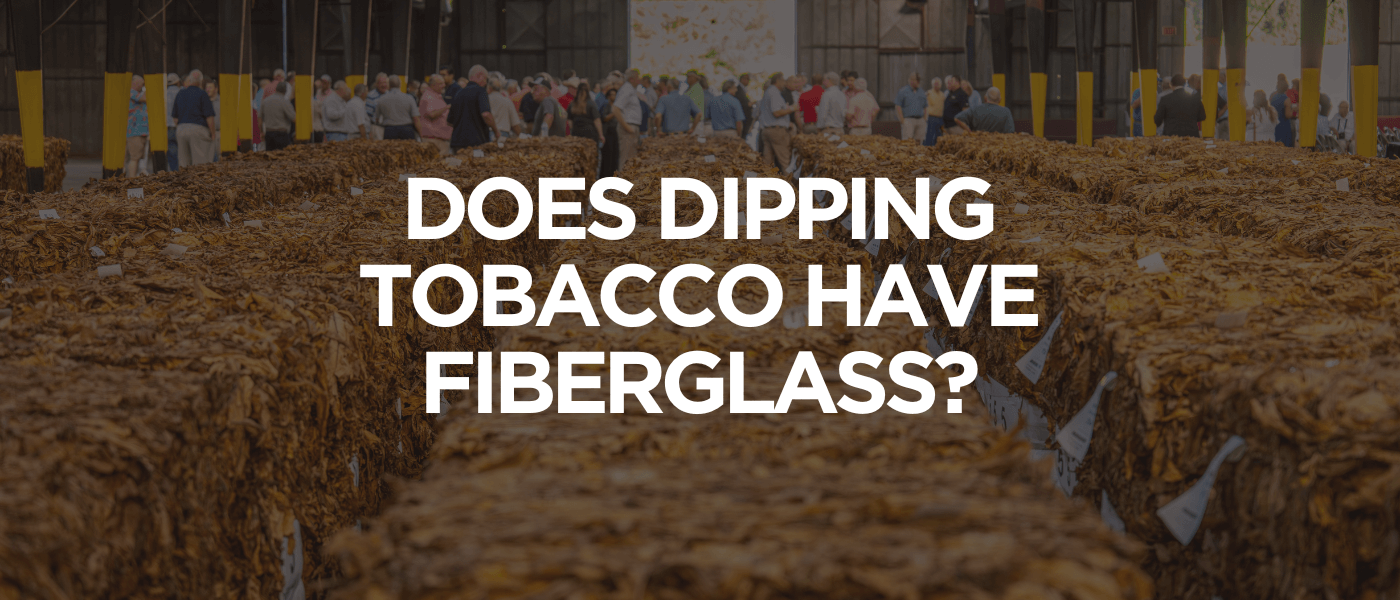Uncategorized
Does Dip Tobacco Have Fiberglass?
Smokeless tobacco products have become the go-to source of nicotine for users who don’t want to smoke any combustible tobacco like cigarettes and cigars. Through smokeless tobacco products, they can essentially get their nicotine fix without bothering others with secondhand smoke. They can likewise carry on with their work or task, as long as tobacco products are permitted to consume.
Many smokeless tobacco products still exist today, despite the growing popularity of modern nicotine delivery systems like vaping devices and nicotine pouches. One of these products is dip tobacco. Also known as moist snuff, it is a form of smokeless tobacco that is placed between the lip and gum.
Dip tobacco has been around for decades and remains popular among tobacco users who want a nicotine fix without smoking. Concerns about its ingredients, however, have sparked ongoing debates. Some would argue that dip tobacco contains fiberglass. Does dip tobacco really have fiberglass? Continue reading to know the truth.
Fiberglass in Dip Tobacco: Fact or Myth?
Many smokeless tobacco users believe that tobacco consumption through dip tobacco can somehow reduce the health risks they might get in the long run. Dip tobacco, after all, doesn’t require combustion, which makes tobacco smoke non-existent.
The only thing tobacco users must do when consuming dip tobacco is to place it in their mouth and spit out any tobacco juices or spit that may build up over time. And to ensure the surroundings remain clean and mess-free, dip tobacco users bring their own spit cup or bottle to somehow store the juices.
One interesting thing about dip tobacco is it comes in many flavours and scents. Native Smokes 4 Less currently offers dip tobacco in a wide plethora of flavours to effectively cater to a wide range of smokeless tobacco users. These flavours include Apple, Berry, Wintergreen, Citrus, and Spearmint. Some brands that offer dip tobacco include Skoal, Stoker’s, Copenhagen, and Grizzly.
Dip tobacco is then available in two forms: loose strands and small pouches. If you want to opt for dip pouches, Native Smokes 4 Less also sells them.
Now, since dip tobacco or snuff tobacco doesn’t require combustion, one would assume that it is completely safe and not addictive. But the truth is, dip tobacco still contains tobacco, which is a main source of many chemicals that can be dangerous to one’s body.
If you are consuming smokeless tobacco like dip tobacco regularly, you are putting yourself at risk of the following health effects:
- Cancer: Smokeless tobacco, like dip tobacco, has high levels of chemicals that may cause various types of cancer like oral cancer, pancreatic cancer, and esophagus cancer.
- Tooth decay and mouth sores: Dipping tobacco with high sugar content can often cause tooth decay and painful mouth sores.
- Poor gum health: If your gums started to pull away from the teeth, then it might be due to consuming dip tobacco. Consuming dip tobacco continuously could then lead to loose teeth.
- Others: Other health risks associated with dip tobacco consumption include cardiovascular disease, asthma, and deformities in the female reproductive system.
Dip tobacco can also be addictive due to its nicotine content. Nicotine, in general, is a stimulant that helps activate feelings of pleasure, relaxation, and alertness. Its effects, unfortunately, are short-lived. So, to ensure you get the same sensations, the only thing you can do is take tobacco products again, which could eventually lead to nicotine dependence and tobacco addiction.
The more nicotine you have in your body due to dip tobacco, the more negative health risks may occur and develop in the long run. Some side effects of taking in nicotine in various parts of your body are:
- Central nervous system: Dizziness and lightheadedness, sleep disturbances, changes in blood flow, and headaches.
- Cardiovascular system: Increased risk of blood clotting, increased blood pressure, and changes in heart rhythm and rate.
- Respiratory system: Shortness of breath, bronchospasms, and increased risk of lung conditions such as chronic obstructive pulmonary disease.
- Muscular system: Tremors and joint pain.
- Gastrointestinal system: Peptic ulcer, diarrhea, nausea, dry mouth, and indigestion or heartburn.
Aside from tobacco ingredients, dip tobacco contains other elements that can somehow improve their nicotine delivery, taste, and many more. Now, some people believe that dip tobacco contains fiberglass, as the said smokeless tobacco is known to provide a sensation of small cuts or irritation in their mouth.
Based on most scientific evidence and regulatory sources, dip tobacco doesn’t contain fiberglass. There’s no confirmed evidence that tobacco brands and manufacturers intentionally add the said element to dip tobacco products.
So, why do some people believe that dip tobacco has fiberglass?
The idea most likely started as a way to explain the small cuts or irritation that some tobacco users feel in their mouth whenever they use dip tobacco. They thought that fiberglass creates cuts inside the mouth, allowing the nicotine to enter the body and get through the bloodstream more quickly.
The irritation you might be feeling when using dip tobacco is real. However, it doesn’t come from fiberglass. Instead, it comes from the salt content of dip tobacco. Its pH levels can likewise create the said sensations. Together, they can irritate the mucous membranes, especially with frequent or prolonged use of the dip tobacco.
Copenhagen and Skoal, as mentioned earlier, are two of the most popular brands that sell dip tobacco. Both brands have denied the use of fiberglass in their products. They have also disclosed all ingredients and additives used in making dip tobacco to the US Food and Drug Administration and Health Canada. And based on their list of dip tobacco elements, there’s no indication that fiberglass is present.
All the rumours regarding dip tobacco having fiberglass are a complete myth, despite many anti-smokeless tobacco (anti-ST) activists continuously claiming the existence of such an ingredient on smokeless tobacco products like dip tobacco and chewing tobacco. The only time researchers have found evidence suggesting the use of fiberglass in tobacco products is with some cigarette filters.
Chemicals in Dip Tobacco
Even though fiberglass in dip tobacco is a myth, it still produces a number of chemicals that could be harmful to your health. Some known chemicals that dip tobacco produces include:
- Nicotine: One of the most well-known components of dip tobacco is nicotine. It is an addictive stimulant that can affect your central nervous system. Compared to cigarettes, dip tobacco can deliver more nicotine, which makes it highly addictive. Some brands of dip tobacco may even add alkalising agents to boost nicotine absorption through the gums.
- Tobacco-specific nitrosamines (TSNAs): TSNAs are carcinogenic compounds generated during the curing and processing of tobacco leaves. They are known to be one of the most dangerous chemicals you can get in dip tobacco since they can cause various types of cancers like oral cancer, pancreatic cancer, and esophageal cancer.
- Formaldehyde: Typically used in embalming fluid, formaldehyde could be present in dip tobacco due to the fermentation or chemical reactions it went through during processing. It is currently classified as a known human carcinogen.
- Polycyclic aromatic hydrocarbons (PAHs): PAHs often form as a by-product of incomplete combustion or tobacco curing. Some dipping tobacco products may possess such types of tobacco leaves, allowing them to produce polycyclic aromatic hydrocarbons or PAHs that can be toxic and carcinogenic, even in small amounts.
- Sodium: Dip tobacco often contains high levels of sodium, helping it preserve the product and increase nicotine absorption. However, if you’re often exposed to salt and irritants, it may only lead to gum recession and a high risk of infection.
- Flavorings and sweeteners: To improve taste and appeal of dipping tobacco or pouches, manufacturers add a range of flavourings like mint, wintergreen, and fruit flavours. They are then paired with sugars or artificial sweeteners. While they enhance user tobacco experience, some of them haven’t been studied thoroughly in terms of their long-term safety.
While these chemicals exist in dip tobacco, the number of health risks associated with the tobacco product was found to be less than those related to combustible tobacco products like cigarettes.
The risk of oral cancer from dip tobacco, for instance, is significantly lower than the risk associated with smoking. So, switching from cigarettes to dip tobacco can dramatically reduce the risk of oral cancer and other smoking-related diseases.
Oral leukoplakia, which is the thickening of the mouth lining, can however be found in many dip tobacco users but rarely progresses into cancer. Smoking-related leukoplakia, alternatively, is more likely to develop into cancer.
And while there’s no conclusive evidence that links dip tobacco and other smokeless tobacco to cancer, it is still possible at a very low level. Additionally, smokeless tobacco products may pose a low risk of cardiovascular disease, potentially increasing risk by 3-4% as opposed to smoking.
Frequently Asked Questions
What does tobacco dip have in it?
Tobacco dip has finely ground tobacco leaves, nicotine, flavourings, sweeteners, salt, and preservatives. It also contains moisture-retaining agents to prevent it from drying. Some of its components, particularly tobacco-specific nitrosamines, are known carcinogens.
Do they put fiberglass in dipping tobacco?
No. Tobacco brands don’t put fiberglass in dipping tobacco. This belief is a myth that likely came from the mouth irritation some dip tobacco users experience. The rough texture of tobacco, as well as its chemical content, are more likely responsible for that sensation.
Summary
Dip tobacco and other tobacco products that are smokeless may be less harmful than cigarettes and other combustible tobacco products due to the lack of tobacco smoke and its harmful byproducts. Recent studies have then confirmed and concluded that dip tobacco doesn’t contain fiberglass. Instead, the small cut sensation and irritation one might feel when consuming dip tobacco are potentially caused by the tobacco’s pH level and salt content.
Although dip tobacco doesn’t have any fiberglass, you must remember that it still contains tobacco, which may produce a number of addictive or potentially harmful chemicals like nicotine, tobacco-specific nitrosamines, and so on. Therefore, it’s important that you consume it in moderation.
Are you looking for the strongest dipping tobacco out there? If so, then Native Smokes 4 Less is here to help you discover the strongest dipping tobacco you can find and use.

